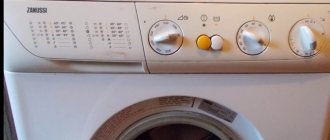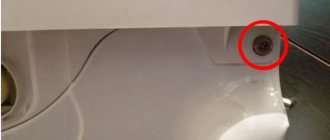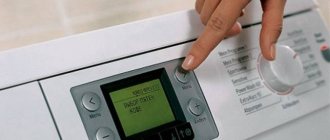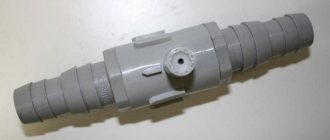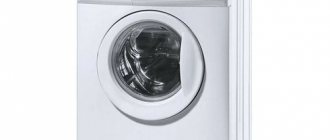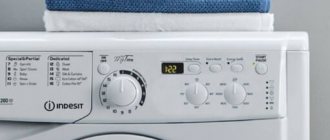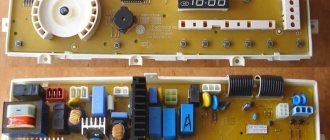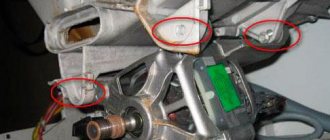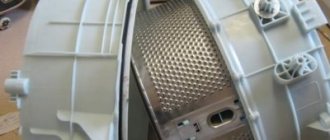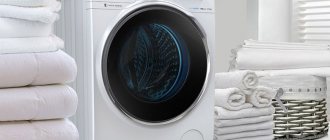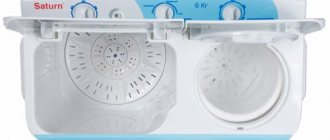Replacing the water supply valve (WSV) of the washing machine
The electromagnetic valve (SEV) of the washing machine regulates the water load (according to the specified washing programs).
Water is drawn in by applying appropriate voltage to the coil. The resulting electromagnetic field pulls the rod into the coil, opening the membrane. Water is supplied to the tank. When the current is turned off, everything returns to its original position. Intake devices can be equipped with a different number of coils (1 - 3). The device depends on the features of the model. The single-section inlet valve is used exclusively with a control device that regulates flow distribution. In computer controlled machines there is no need for a mechanical drive. Here, three- and two-section intake valves are used (with this design option, a thermal pusher is used). The sectional flow distribution in a two-section device for the third section changes when the two coils operate simultaneously. The flow is switched by a special device - a thermal slider.
Error codes
The machine itself informs the user about some breakdowns by displaying a special alphanumeric sequence on the display - an error code. Here are some of them:
- E11 – insufficient water supply during washing. As already mentioned, you need to check the water fill path, filter and valve.
- E13 - there is a water leak into the pan.
- E21 – problems with draining water. Most likely the drain filter needs to be cleaned. Along with clothes, sand, seed husks and other small debris, buttons, pins and other small objects can get into the machine, so it is recommended to clean the drain filter after every 3 washes. If this measure does not give a positive result, it is necessary to check the functionality of the pump. The resistance of its winding should be approximately 170 Ohms.
- Codes E23 and E24 indicate a malfunction of the control semistor of the drain pump in the control module.
- E35 - the water level in the tank has exceeded the permissible threshold. The most likely cause is a broken level sensor or a clogged tube.
- E41 - E45 indicate a malfunction of the hatch lock or its blocking elements.
A washing machine breakdown is not that uncommon. Some brands of units have their weak points. Kandy washing machine - do-it-yourself repair of basic faults, read on.
We will analyze the types of mixer taps and the features of their design in this material.
Probable malfunctions and their diagnosis
Replacing the filling valve of a washing machine may be necessary when the water supply is disrupted or stopped.
Procedure for diagnosing a malfunction
- Check the filter mesh, clogging of which prevents the normal flow of water.
- Dismantle the part, connect the inlet hose, lower it into the container, apply voltage to the coils one by one. In good condition, when voltage is applied, the valve is open, when disconnected, it is closed. If it stays closed, the coil is probably burned out. There will be no water inlet.
- If water flows in, but after shutting off it continues to flow out, the membrane has become unusable or the rod spring has been completely weakened. Here it is necessary to replace the water supply valve in the washing machine.
You should also check the presence of inserts pressed into the fittings. If they are missing, the compartment overflows and disrupts the proper order of program execution. In such a situation, the solenoid valve should be replaced.
In almost all situations, in the event of pressure disturbances during supply/no flow, the failed unit should be replaced.
Puddle formation
If water is detected under the washing machine, the following components should be checked:
- Gasket at the connection point of the filling hose. If excessive wear occurs, it must be replaced.
- Hatch seal. Over time, this element may become deformed or crack. To dismantle a worn cuff, it is necessary to remove the clamp holding it. It fits quite tightly, but if you pry it with a screwdriver, it comes off quite easily.
- The drain pipe or the location where the drain hose is attached to the pump. If there is damage in this area, water will begin to seep in as the machine fills. A damaged part - a hose, pipe or pump - must be replaced.
- Car tank. Leaks may be due to its depressurization.
In the latter case, specialized equipment will be needed for repairs, so you will have to contact a service center.
How to replace a damaged part
For almost any reason that arises, you can repair this unit yourself. In most cases, this part is located at the back and top - near the lid.
Method for replacing a failed unit
Close the water supply valve.- Disconnect the supply hose.
- Remove the top cover. The solenoid valve must be accessible.
- Disconnect the electrical wiring.
- Disconnect the connecting hose of the valve and the fitting.
- Remove fasteners.
- Install fasteners (latches or screws).
- Dismantle the part that has become unusable.
- Change the valve.
The unit is assembled in the reverse order of disassembly, following a strict sequence of actions. After installation, the functionality of the entire mechanism is checked.
Features of replacing a unit in a SMA with vertical loading of laundry
On top-loading machines, the inlet may be located in the plinth area of the rear wall. Replacing the inlet valve on this type of washing machine may require removing the side wall.
On the Internet you can find detailed video tutorials on the repair procedure. SMA LG, Indesit and other brands have some repair features, but the principle of replacing a damaged part is almost the same for all models.
If replacing spare parts yourself is not possible, you should contact a reliable service center that services this brand of unit.
When choosing a service center, you must carefully study the experience and user reviews of the service provider. Public opinion, expressed in impartial customer reviews regarding the competence of the craftsmen, is sometimes much more valuable and objective than numerous certificates displayed for public viewing on the official website of the service center.
Source
Water does not fill
We are looking for the cause of the malfunction:
- First you need to make sure that the water has not been turned off.
- Next, you need to check the capacity of the filling hose by disconnecting it from the machine and turning on the water supply.
- If water flows through the hose properly, install it in place and check the condition of the filter. Together with the filling valve, it is located in the place where the hose enters the unit body. After removing the top cover, the assembly (valve + filter) must be unscrewed, after which the filter can be disassembled and cleaned.
Cleaning filters, both inlet and outlet, must be done regularly, without waiting for problems to arise.
If the water supply has not resumed, you need to check the functionality of the filling valve. The resistance of its winding should be 3.75 kOhm, and when the voltage indicated on the case is applied to the contacts, the device should open. A malfunctioning valve must be replaced.
This problem may also indicate that the level sensor is broken or its tube is clogged.
In many cases, the owner of the washing machine can repair it himself. Repairing a Bosch washing machine yourself - an overview of the main types of breakdowns and methods for eliminating them.
What criteria should be taken into account when choosing a shower cabin, read in this topic.
Failure of the heating element, wear of the bearing, failure of the control unit - these types of faults in washing machines are the most common. Here https://aquacomm.ru/cancliz/mnogokvartirnyie-doma/santehnika/stiralnaya-mashina-indezit-neispravnosti-remont-svoimi-rukami.html you will learn how to fix Indesit machine breakdowns yourself.
How does the filling system work?
The water inlet valve for the washing machine is equipped with a thin membrane on the inside and coils on the outside. The main control module signals that the valve is turned on. Then an electric current is supplied to its coils, which contributes to the appearance of a magnetic field. This causes the membrane to open, allowing water to flow in. After the voltage supply ends, the membrane closes again.
Thus, the water inlet (supply) valve has two positions - open and closed.
Number of coils: what does it depend on?
Their number depends on the model of the washing machine. In modern SMAs, the manufacturer installs from two to three sections, so that each of them supplies water to a specific compartment of the powder receiver.
- 1st section: powder section.
- 2nd section: rinse aid compartment.
- 3rd section: department for other funds.
If there are only two spools available to pick up detergent, they turn on simultaneously.
Older models used a fill valve for a single spool washer. It worked in conjunction with a command apparatus, the lever of which regulated the movement of the flow in a certain direction.
Where is the valve located?
Where is the solenoid valve located in the SMA? It is located under the top panel near the wall. You will see hoses connected to it that carry water to the detergent compartments.
Signs of breakdown
The malfunction can be determined by external signs:
- Error code on the washing machine display.
- Water is drawn into the tank without stopping.
- When starting the machine, there is no sound of water intake.
- The tank is overflowing with water.
Read more about how to check and replace the inlet valve of a washing machine below.
How to find the problem yourself
Before checking the solenoid valve, inspect the mesh filter. It is located between the intake hose and the inlet valve and serves to retain particles of debris coming from the water supply.
Since the filter could become clogged over time, we will describe the principle of cleaning it:
- Disconnect the CM from the power supply.
- Close the inlet valve.
- Unscrew the inlet hose and drain the remaining water from it into a sink or other container.
- Behind the hose you will find a mesh. Pull it out using pliers and clean it under running water.
Let's look at how to open and check the inlet valve in a washing machine.
- Remove the lid on the top of the washer. To do this, unscrew the screws from the back that hold the top cover.
- Inspect the valve for damage. If nothing is visible from the outside, remove the device.
- Disconnect the hoses leading to the valve. First you need to loosen the metal clamps, so use pliers.
- Now disconnect the wiring.
- Unscrew the bolts securing the part to the SMA body.
- Pull out the valve.
Inspect the hoses and the device itself for blockages. How to check the fill valve? Check over a container or sink to avoid getting wet on the floor.
Connect the intake hose to the valve and open the water. If the element is working properly, it should not leak water. If it leaks, then replacement is needed.
The next test option must be carried out quite carefully. You must apply a voltage of 220 Volts to the coils of the device. In this case, the section should open and fill the container with water. The danger of this method is that when electricity and water come into contact, a short circuit may occur. Therefore, you need to work very carefully.
You can accurately determine whether the washing machine valve needs repairs using a multimeter. Set the tester to resistance measurement mode. Apply probes to each winding one by one, measuring its resistance. A working part should show a result of 3 kOhm.
No water heating
Most often, the cause of such failures is the breakdown of the heating element - due to natural wear or due to scale accumulation. Follow these steps:
- After unscrewing the fasteners, remove the back panel of the case.
- Check the resistance of the heating element using a multimeter (its shank with the wires connected to it protrudes from the tank in its lower part). At room temperature, the device should show 30 ohms.
- If the resistance is different from normal, the heating element must be replaced. The wires are disconnected from it, and then the nut located between the contacts is unscrewed. After this, the heater can be pulled out. This should be done with caution, gently rocking the element and without applying excessive force. If the heating element is stuck and does not budge, you need to soften the scale with WD-40 liquid. After dismantling the heater, its seat needs to be cleaned, after which a replacement can be installed. The new heating element must match this model of washing machine. A heating element from another model may burn out, along with the control module.
- If the resistance measurement shows that the heating element is working properly, you need to check the condition of the temperature sensor. Its performance is also checked by measuring resistance. At room temperature it should be 5.7 - 6.3 kOhm.
The reason may also be the “sticking” of the contacts of the heating element relay located near the control module.
Solenoid valve for a washing machine as one of the main elements
Solenoid valves for connecting various devices to water supply systems are used quite often. Such devices have an electromechanical principle of operation and are a type of locking equipment. Experts call them solenoid (solenoid - magnet).
Solenoid shut-off elements are often found in various industries, in water and gas supply systems. In accordance with its functions, in washing machines this device is called a filler or inlet valve.
Purpose of the inlet valve
All washing machines such as Indesit, Samsung, Ariston, Zanuzzi and other models are necessarily equipped with a solenoid valve.
This device has two operating states: open and closed. As soon as the washing program is selected, the mechanism of the electromagnetic device will work and open, after which water will begin to flow. The volume of water is controlled by an electronic module, which in turn controls the operation of the pressure switch and the inlet solenoid valve. The filling device is activated by supplying power from the control unit to the coil of this device.
The water supply valve for a washing machine acts as a shut-off valve, essentially a tap that opens and shuts off the flow of water into the washing tank through a container with detergents at the right time, according to the washing mode.
Approximate prices
Russian service companies set approximately the following prices for replacing washing machine bearings:
- With a collapsible tank - from 3300 rubles.
- With non-separable – from 5500.
- Additional work to remove the machine from the furniture - from 500.
- Diagnostics are free.
- The technician’s visit is free of charge (if repairs are planned from a visiting specialist. An urgent call is paid depending on the distance of the technician from the object).
Approximate prices for bearing replacement, taking into account the brand of washing device:
- Bosch - from 3900 rubles.
- Indesit – from 3500.
- Samsung – from 4200.
- LG – from 4300.
- Ariston – from 3500.
- Candy – from 3800.
- Electrolux – from 4000.
- Zanussi – from 3900.
- Miele – from 6300.
- Whirlpool – from 4600.
- BEKO – from 3400.
- Siemens – from 4500.
- Ardo – from 4600.
- AEG – from 4200.
- Brandt – from 4700.
- Atlanta – from 3300.
- Gorenje – from 4200.
- Hotpoint Ariston – from 4000.
- other brands – from 3300 rubles.
Water supply valve device
The inlet solenoid valve of a household washing unit is a small device consisting of:
- housings;
- electromagnetic coil with core;
- springs;
- a disk mounted on a core that blocks the flow of water coming from the water supply.
The body material in most cases is various types of heat-resistant polymer materials, less often brass or stainless steel. For the manufacture of membranes, gaskets and seals, heat-resistant rubber, caoutchouc, fluoroplastic or silicone are used. Electric magnets with rigidly fixed parts (solenoids) are installed in the retractor coil. Depending on the number of solenoids, they can be one, two, or three-coil. The number of coils corresponds to the number of sections of the device through which tap water flows into the dispenser. Electromagnetic valves of washing machines from different companies may differ in materials of manufacture, appearance or number of coils, but the operating principle of all such elements is the same.
Working principle of water supply valve
The inlet valve of the washing machine is controlled by the control module. In a stationary position, when no voltage is applied to the coil, the valve is closed, and its membrane, due to the spring, is in hermetically sealed contact with the seat of the device, reliably shutting off the pressurized water in the water supply. When the processor sends an electrical signal to the coil, the rod, under the influence of an electric field, is drawn into it, dragging the piston along with it. The device moves from the static “closed” position to the “open” position. When the electric current supply is interrupted, the rod returns to its previous position and the water supply is interrupted. All coils of household washing units are designed for a normal voltage of 220 V and a clock frequency of 50 Hz.
Technically outdated samples were equipped with a single-coil electric valve, in which the flow of water into various sections of the plastic dispenser was carried out through the lever of a mechanical command device. In modern machines equipped with two- or three-coil types, under the control of the processor, one of the coils is turned on, ensuring the supply of water to the required section of the dispenser. In two-coil versions, both coils are turned on simultaneously to supply water to the third section of the dispenser.
Increased speed
The first step in such a situation is to check the serviceability of the engine and the integrity of the power circuit.
Without sufficient experience it will be difficult to do this, so it is better to contact a service center.
Here, if necessary, they will check the correct operation of the control module circuit - perhaps it is sending incorrect commands to the device.
Types of intake valves
Water supply valves for LG, Samsung or Indesit washing machines may have various technical differences. Almost all manufacturers install normally closed valves on their units. Normally closed valves are valves that open when voltage is applied to the electromagnetic coil.
The inlet valves of washing machines can be divided into:
By the number of electromagnetic coils
- single-reel (outdated washing units);
- two-reel (most budget models);
- four and five reel (some models);
2. Based on the materials used to manufacture the case
3. According to the sizes of water supply fittings
There is also a universal fill valve for washing machines on sale, marked 1/90, which means there is one outlet located at an angle of 90 degrees relative to the inlet fitting. The metal mounting plate of such a valve is removable and can be adjusted at different angles. The diameter of the solenoid valve nipple is 10.5 mm, and the inlet fitting is ¾ inch. This universal solenoid valve is suitable for washing units from most manufacturers that have a single-coil version of the device installed.
Malfunctions of inlet valves and their replacement
If the washing unit has been idle for a long time and tap water has accumulated in the washing drum, the inlet valve most likely needs to be replaced. If the washing unit, for some reason, was left in a room with sub-zero temperatures, then due to the freezing of the water accumulated in it, the body of the device may crack. In this case, it is also changed entirely.
If the water supply is poor, sometimes it is enough to clean the filtration mesh to restore operation. To do this, you need to turn off the water and remove the water supply hose and remove the contamination by pulling out the mesh with pliers and then putting it in place.
The main malfunction of solenoid valves is a malfunction of the electromagnetic coil. If the coil is burnt out and does not retract the rod, water does not flow into the washing tank at all. Most modern units are equipped with electric valves that have a non-separable design, so they cannot be repaired. It is better to carry out replacement with the assistance of a specialist. You can carry out the repair yourself by purchasing a new filling electric valve, similar to the one that failed. To do this you need:
- turn off the power to the washing unit;
- turn off the water supply and disconnect the water supply hose;
- remove the lid or side wall (for top-loading machines) of the washing machine;
- disconnect the electrical wiring and hose (or hoses) associated with the dispenser section;
- unscrew the fixing plate bolts;
- remove the device;
- check performance using a multimmmeter. The winding of a single-coil valve should “ring” at 3.8 kOhm (on older Samsung models 4.5 kOhm), for double and triple coils this figure ranges from 2 to 4 kOhm;
- Replace the solenoid valve with a new one, reassembling it in the reverse order.
Repair of Zanussi washing machines
This public offer Agreement, hereinafter referred to as the Agreement, defines the relationship between the administrator of the domain zns-remont.ru, hereinafter referred to as the Administrator, on the one hand, and the visitor to the site zns-remont.ru, hereinafter referred to as the Visitor, who accepted this offer to conclude an Agreement by carrying out actual actions to fill out an online form, application or call the contact phone number indicated on the Site, or send an email or application to other contact information indicated on the Site.
Clarifications of terms and definitions
1.1. Administrator’s website – website: https://zns-remont.ru.
1.2. Site Service - navigation capabilities, receiving and sending information available for use on the Site by the Visitor.
Subject of the Agreement
2.1. The Administrator provides the Visitor with access to the Site Service, and the Visitor undertakes to use the Service in accordance with the terms of this Agreement.
2.2. The Administrator undertakes to accept information from the Visitor, including requests for repair work.
2.3. The Administrator undertakes to transfer information and requests for repair work received from the Visitor to potential contractors, subcontractors and other persons at the discretion of the Administrator.
2.4. The Administrator is not responsible for the consequences of the resulting relationship between the contractors and the Visitor, including, but not limited to, inadequate quality and content of service, repair and other work.
Other conditions
3.1. The content of the Site, one way or another capable of causing associative connections in the Visitor with officially registered trademarks, as well as brands, logos and other parts and elements of trademarks, is a random and unintentional coincidence.
3.2. Official copyright holders of trademarks who have noticed similar elements in the content of the Site have the right to contact the Site Administrator for clarification. If agreements are reached, controversial and random associative elements can be removed by the Administrator or modified to the point where the association with the registered trademark is objectively lost.
3.3. This Agreement establishes the complete absence of any relationship between the Site and the official representation of any brand, manufacturing or trading company registered in the manner prescribed by law. The Site is also not an official authorized dealer and/or service center of any registered brand or company, but provides only services for access to the service and functions of the Site, which boil down to the Visitor searching for the best option for receiving repair and maintenance services for his vehicle. he owns household, kitchen and other general purpose appliances.
3.4. Disputes arising between the Administrator and the Visitor may relate exclusively to functional, service and software errors in the structure of the Site and the incorrect operation of its program code. All disputes regarding the quality of repairs or service received by the Visitor are resolved exclusively with the person who provided these services to the Visitor.
3.5. The Parties are released from liability for complete or partial failure to fulfill obligations under the Agreement if the failure to fulfill obligations was the result of force majeure, namely: fire, flood, earthquake, strike, war, actions of government authorities or other circumstances beyond the control of the Parties.
Final provisions
4.1. This Agreement is a document regulating the relationship between the Administrator and the Visitor, as a result of which the Visitor, performing any actual action in the software shell of the Site, including reading content, filling out forms and fields, sending requests and messages and any other actions related to the use of functions and service capabilities The site automatically joins this Agreement in full.
4.2. A hyperlink to this Agreement is located on the main page of the Site, and is available in the form of a pop-up dialog box for easier viewing and reading.
4.3. The Visitor’s refusal to familiarize himself with the text of this Agreement in the presence of actual actions indicating the use of the functionality and services of the Site is considered void, and the Visitor is deemed to have agreed to all the terms of the Agreement on the grounds of actual use of the Site’s capabilities.
